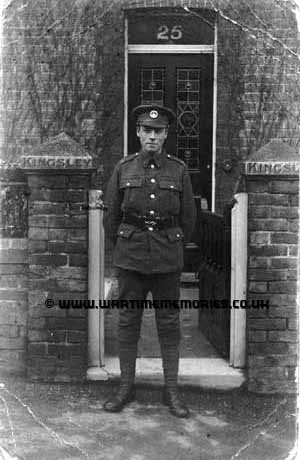Your message will be forwarded to the last contact details we have, your email address will not be passed on, they can reply to you via this messaging system.
Please scroll down to send a message.
Pte. John Bernard Coggins
British Army 6th Service Battalion (Pioneers) South Wales Borderers
from:39 Shakeshaft Street, Blackburn, Lancs
My father, John Coggins, was shot in the neck and gassed on the 10th of April 1918 in the River Lys area during the German offensive. On recovery in Blighty he attended a Gas Instructors Course and his notes (122 pages long with coloured crayon diagrams) are currently on indefinite loan at Winterbourne Gunner (the NBC Instructors training school) and are used for training to this day. Frank Baldwin, Chairman of the Battlefields Trust, also uses them as an aid in his WW1 tours with Sandhurst cadets and the The Western Front Association has a flicker page link to them on their website.
John Bernard Coggins joined the young soldiers' unit of South Wales Borderers on 23 September 1916 Regimental Number 41722. He transferred to 6th (Service) Battalion (Pioneers) which was attached to 75th Brigade, part of the 25th Division. He was with his Unit throughout almost all the German offensives in the Spring of 1918 and eventually when his Unit became decimated he attached himself to French Canadians and was severely wounded in the neck and jaw on the 10th of April 1918.
The following action (part of the German Luddendorf Offensive) is probably when neck and jaw wound were received (extracts from the Official History of the 25th Division).
The Battle of Estaires (first phase of the Battles of the Lys) - 74th Brigade was in Divisional Reserve when the enemy attacked the British positions to the south (between Armentieres and Givenchy) on 9 April 1918. It was ordered to join the defence south of Steenwerck and held on only with difficulty.
The Battle of Messines, 1918 - The enemy attack broke through the British line at Ploegsteert and advanced along the Ypres road, endangering the garrison holding Ploegsteert Wood. Ordered to counter attack, 75th Brigade, the Royal Engineers, Machine Gun Battalion and other elements of the Division became involved in heavy fighting. With the enemy infiltrating on either side on 10 April, losses at the Catacombs of Hill 63 were serious although there were many remarkable acts as some units managed to extricate themselves and withdraw. Further retirements were forced upon the Division - which also had 100th Brigade of 33rd Division under orders - on 12 April; the forward position on this day ran through Kortepyp. The army's line of defence that ran in front of Dranoutre and Kemmel, was held by a hastily organised composite force of units and men of the Division.
The Battle of Bailleul - By the morning of 13 April, 74th Brigade was established on the high ground east of Bailleul. Coming under bombardment from 9.30am onwards and attacked by infantry two hours later, the Brigade fought a staunch defence - as did 7th and 75th Brigades nearby. Fighting continued throughout the 14th, and next day the high ground and the town of Bailleul itself fell to the Germans. The Division was by now thoroughly shattered: broken up, exhausted by continuous fighting for five days, and fragmented by heavy losses. A sad composite formation of what was left of 7th and 75th Brigades withdrew through Boeschepe on 16 April but were ordered up to the area south of Mont Noir in support of 34th Division.
The First Battle of Kemmel - By 17/18th April it had been withdrawn to Abeele. 74th Brigade came out to Proven on 20/21 April.
According to my father when he was shot, he fell into a trench where barbed wire ripped off his gas mask and he was gassed. A Canadian dragged him back to a first aid station. He was invalided home (apparently all head wounds went back to Blighty). He recovered sufficiently to rejoin his reserve Battalion of SWB and after certain moves on drafts joined as a prospective NCO of 53rd Young Soldiers' Battn (SWB). When this Unit was being prepared for service overseas the now Cpl Coggins was promoted in Battalion Orders to Sergeant but on appeal was permitted to revert to his rank of Corporal seeking early demobilization to return home to his very aged parents. He qualified as a 1st Class Anti-Gas Instructor at Western Command Course, Prees Heath, nr Whitchurch, Shropshire and Drill Instructor and when his Unit left (South Wales) for the Rhine Army of Occupation he was transferred (category B2) to North Elham in Norfolk as Senior NCO of the Guard of POWs until demobilization in 1919.
Anti-Gas Instructor 1st class 6th Jul 1918 and NCO Drill Instructor 1st class Oct 1918.
He served from Jul 1919 until 13th Nov 1919 at POW camp in North Elmham, Norfolk. Acting Corporal. Discharged 31 Mar 1920. Initially received a disability pension of 8'8d pw terminated on 7th Dec 1920 when he passed a medical.
